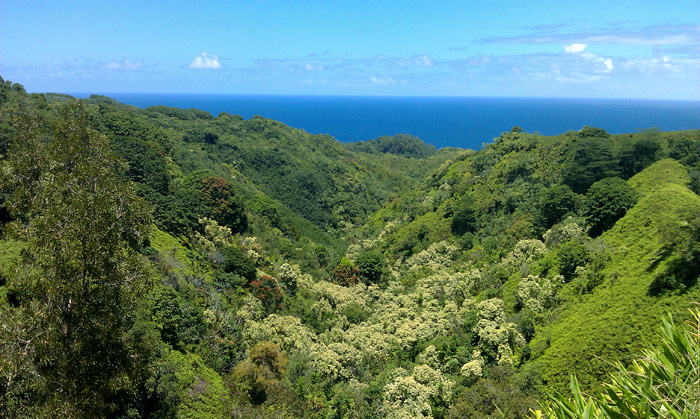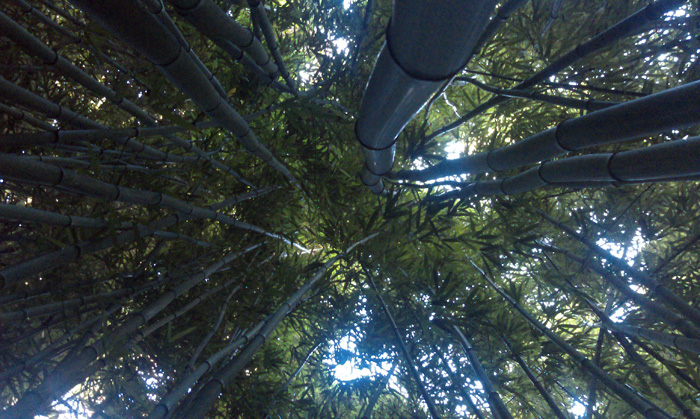Maui – Day 4-5: The Road to Hana
…continued from Day 1-3: Haleakala and West Maui Mountains
Day 4: The Badassery is in the Journey
Flat tire. Fuck. There goes my early start.
I went ahead and switched it out, but realized that I needed some extra tubes for the rest of my trips in case it happens again out on the Hana Highway. The nearest bike shop in Kahului didn’t open until 9. I guess I had some time to kill. I walked around Wailuku in the early morning as the town was still waking up. I checked out of the hostel and coasted down to Crater Cycles in Kahului. Good experience. The owner switched out the back tire for a Gatorskin, which held up for the rest of the tour. He even fixed a truing problem on the wheel free of charge. I needed the reassurance that my bike would hold up on the Hana Highway’s own set of surprises. Riding with confidence in your bike’s ability to not break down in the middle of nowhere is pretty damn important.
I set out eastward on the Road to Hana at a good, hard pace, easily passing the town of Paia. It had a busy downtown strip of old buildings and shops, and was already drawing a lot of traffic. As before, the straight road gave way to turns around cliff sides and rugged coastal rainforest. Famous for its diverse landscape, winding roads, sheer drop-offs, waterfalls, and numerous interesting places to stop every few miles, the Hana Highway is often noted by travel enthusiasts as one of the Best Highways in America. I pretty much agreed, although it did have its share of challenges. Like West Maui, the road was pretty wild.
But it would be worth it to see Hana, a small east coast town of 1,235 people. It is popular for its beaches, hiking trails, lava caves, and a general store of more than 100 years, and draws many people looking for a remote Hawaiian experience. Having the charm of a small town, Hana remains largely unchanged by Maui’s commercial developments further west, which is how they like it.
This kind of country was what drew me here instead of one the other islands. When I scoped out Oahu, it seemed pretty overrun with tourists and commercialism, all at the expense of a person’s solitude. And then some of the other islands didn’t appear to have as much diversity as Maui, whose rainforests and barren, volcanic landscapes offer a change of scenery around every turn. Thirty miles into the Road to Hana, I was certain I made the right decision to come here. It was fucking beautiful.
I went up and down the rugged shoreline for hours before reaching Puokohamoa Falls, where tourists were surprised to see me out there hitting all those tough hills. I told them it was a piece of cake, and started another big climb that went away from the shore and inland for 6 miles. It wasn’t really a piece of cake, it was actually getting a beating, a few feet a time up the side of the same volcano that wiped me out a few days before. And then all at once, I crested the highest ridge, turned back to the sea, and coasted down to Hana for 12 awesome miles straight. On the newly paved road, I felt like I was floating an inch above the ground. Hana may be a gorgeous place, but the badassery really is in the journey.
Just north of the town, I turned off the highway towards Waiʻanapanapa State Park, found the campground, and set up my tent in the mid-afternoon, making pretty good time.
Waiʻanapanapa is an especially rugged, volcanic section of the coastline just north of town. With a great coastal trail, black sand beach, water caves, blow holes, and a spectacular sunrise every morning, there is little not to like. A person could spend days at this place and never get bored. After setting up camp, I spent the next hour walking up and down the trails around the ashen volcanic cliff sides, watching treacherous waves crash against the walls. Apparently, the water here was full of undertows and hazardous currents, waiting for its chance to drag an unsuspecting person out to sea.
That night, I walked out around 2am and looked out at the ocean. Even in that hour, there was a glow of blue about the sea, as waves continued to crash violently against black, volcanic cliffs. One of the hardest days of the tour was behind me now, but it wasn’t over yet. I was about to face an even tougher road ahead.
Day 5: Kipahulu – Two Miles of Eye Candy
An awesome, rewarding sunrise set the mood for the next day. I packed up my gear as the golden sun brightened on the water, and left for the Hana Lava Tube. On a piece of land a couple miles north of the park, the cavern, originally named Ka’ Eleku, was carved by lava flow coming down from the high slopes of Haleakala. Its surface crusted over, forming the cavern’s ceiling and an underground conduit that at one time continued to channel lava until whenever the eruption ended. For $12, visitors can explore the tunnel, making it one of Hana’s popular tourist attractions. I planned to meet my friends there before heading out. They were an hour late.
To kill time, I went to a roadside stand nearby and got the best banana bread I have ever eaten, followed by an equally as delicious fruit smoothie with homegrown bananas, mangoes, and pineapple. I was full in no time. The old lady, a type who they refer to as an “auntie” did what aunties like to do and fatten up we younguns. Full or not, she brought me another smoothie. And of course I had to drink it. What choice did I have?
Feeling as bloated as a dead pig, I went back to the main desk at Hana Lava Tube and found Mel, Kim, and Dave. We got flashlights and explored the tunnel for a good hour. The ceilings had lava stalactites that resembled hershey kisses, although I thought they looked like shit. It was cool, don’t get me wrong, but it was the first time I’ve witnessed what turds look like on a cavern ceiling. Besides the crap-covered walls, there were signs describing the different types of lava formations about the cave, a side tunnel caused by back flow, and a door to an abandoned fall out shelter from the cold war era. Cool place.
We came back out, explored the botanical garden maze just outside of the entrance, and then they took off for the campground at Kipahulu, another 12 miles down the highway. I got on my bike and told them I’d see them in a couple hours.
The highway between Hana and Kipahulu was more of the same thing. Winding cliffside turns, an old beat up road, and no shoulder. To add to the fun, a lot of tourists were out driving. I would descend a huge cliff to a bridge and waterfall, with five cars ahead of me and four behind. Sometimes I would stop and let six or more vehicles pass. When I got to the bottom of one of the grades, I passed one of my neighbors from the campground. I’m never one to turn away good road magic, especially beer, so anybody who offers me a drink is a friend of mine. Last night he gave me a bottle of a good craft brew, which always tastes better after a hard day of riding.
Tough road, but only for 12 miles. I coasted into the campground at Kipahulu and found my friends. They went out on the trail while I set up camp and had a look around. The whole area was buzzing with tourists, and with good reason.
Kipahulu is an especially diverse part of Haleakala National Park. A large stream comes down the volcano and pours over two large waterfalls, passes through bamboo forests, and ends at the Pools at O’heo Gulch near the sea. The Pipiwai Trail follows the stream uphill past the waterfalls and forests for two miles before reaching Waimoku Falls, a stunning 400ft drop of water over a vertical face of volcanic rock and moss. I spent a good hour hiking up there. The bamboo forests had a dark canopy above them, though beautiful, made me what kind of evil lurks in those trees. Just beneath the canopy, wind blew the chutes back and forth, creating a hollow knocking sound that I can distinctly remember to this day.
After taking a good look at the waterfalls, I descended back down the canyon for an hour towards my campsite, looking forward to the luxuries of car camping. As I walked back, I noticed the “big island” of Hawaii to the east, and Mauna Kea rising high above the ocean. At a summit of 13,803 feet, Mauna Kea is the largest volcano in Hawaii. At that altitude, it rises high above the cloud line and retains low humidity, making it an ideal base for astronomical research. A section of its summit is zoned for research facilities owned by various countries, and there are thirteen telescopes in operation, gathering information and data from space.
I descended the hill to the campground as the setting sun reflected its light from one of the telescopes. From 60 miles away, it looked like a star had just come up over the summit. This was by far the most remarkable thing I saw on my trip.



